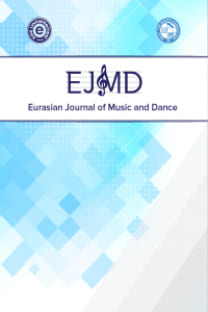TURKS IN SLOVENIA AND THEIR INFLUENCES ON SLOVENIAN MUSIC
TURKS IN SLOVENIA AND THEIR INFLUENCES ON SLOVENIAN MUSIC
invasions i.e. irruptions, influences, themes in music folk and artificial music, church and secular repertoires,
___
- BELOKRANJSKA dediščina 4. 2008. Metlika: Katalog razstave.
- BELON, Pierre du mans. 1553. L’Observations de Plusieurs Singularitez. Paris: Guillaume Cavalet & Gilles Corozet.
- BENEDIK, Metod. 1992. Cerkvene razmere na Slovenskem ob prihodu jezuitov; Jezuiti na Slovenskem.
- Ljubljana: Inštitut za zgodovino Cerkve, Provincialat slovenske province Družbe Jezusove.
- ČERIN, Josip. 1927. Zgodovinski razvoj vojaških ozir. turških godb (see in: Pevec, L. 7/No. 3-4). Ljubljana: Pevska zveza.
- ČOPIČ, Špelca. 1967. Socijalna umetnost u Sloveniji (see: Jugoslovenska umetnost XX. veka, 4, (1929-1950). Beograd: Muzej savremene umetnosti.
- SOJAR Voglar, Črt. 2012 (see: http://www.dss.si/?avtorspada=58&lang=slo).
- http://en.wikipedia.org/wiki/Piano_Sonata No. 11_Mozart.
- http://lit.ijs.si/turki.html.
- http://sl.wikpedija.org/wiki/Matja%C5%BE_Jarc.
- http://sl.wikisource.org/wiki/Turki_na_slovenskem_%C5%AOtajerskem http://sl.wikipedija.org./wiki/Tur
- http://www.hurriyetdailynews.com/n.php?n=beethoven-was-inspired-by-a-mevlevi-piece-f...
- http://www.promin.si/svetovanje/problematika/islama.htm
- HUPCHICK, Dennis P. and Harold E. Cox. 2001. The Palgrave Concise Historical Atlas of the Balkans. New York: Palgrave.
- JEZERNIK, Božidar. 2012. Imaginarni “Turek”; Ljubljana: Zavod Republike Slovenije za šolstvo.2012. Katalog
- glasbenih del / Music Catalogue. Ljubljana: Društvo slovenskih skladateljev / Society of Slovene Composers.
- KLOBČAR, Marija. 2007. Regiment po cesti gre. Ljubljana: Znanstvenoraziskovalni center pri Slovenski akademiji znanosti in umetnosti.
- KRIŽNAR, Franc. 2004. Peter Kopač. Solistična in komorna glasba / Solo and Chamber Music. Ljubljana: Društvo slovenskih skladateljev / Society of Slovene Composers (CDs). 2008. On Alamut, an Opera
- in Three Acts, by Matjaž Jarc (see: Fontes Artis Musicae, No. 55/2, p. 377-88). Middleton WI 53562
- USA: International Association of Music Libraries, Archives and Documentation Centres (IAML).
- 2012. Razvoj slovenske glasbe od začetkov do danes ... (see: Glasba v šoli in vrtcu, L. 16/No. 3-4; p.
- 32-39). Ljubljana: Zavod Republike Slovenije za šolstvo.
- KUMER, Zmaga. 1992. Oj, ta vojaški boben, Slovenske ljudske pesmi o vojaščini in vojskovanju. Celovec: Založba Drava. Etc. 1997. Slovenske ljudske pesmi. Ljubljana: Slovenska matica.
- LOIR, Sieur du Jeanne Antoine du. 1654. Les Voyges du Sieur du Loir. Paris: Clouzier.
- MIHEVC, Marko. 2012. Two electronic letters (E-Mails) to author (from 7 and 10 Mai 2012).
- PAUŠIČ, Olga. 2012. Vse v naravi se nezavedno vrti. (see: Ona, year. 14/2012, No. 32, p. 26-29. Ljubljana: Delo).
- PERRAULT, Charles M. 1697. Paralleles des Anciens et des Modernes. Paris.
- PROGRAMME. 2009. Ljubljanca, Ljubljanca, oh kaj se godi. Ljubljana: KD Folk Slovenija in Cankarjev dom.
- RUSSINOW, Denison. 1996. Yugoslavia’s Disintegration and the Ottoman Past; V: Carl L. Brown, red.
- Imperial Legacy: The Ottoman Imprint on the Balkans and the Middle East. New York: Columbia University Press.
- SAMEC, Smiljan. 1978. Operne zgodbe. Ljubljana: Mladinska knjiga.
- SIMONTI, Vasko. 1989. Janez Vajkard Valvasor – stotnik kranjskih deželnih stanov; Valvasorjev zbornik.
- Ljubljana. Slovenska akademija znanosti in umetnosti - 2008. Turki so v deželi že; Celje: Mohorjeva družba.
- SLOVENSKE ljudske pesmi (I.). Pripovedne pesmi (SLP I.). [Slovenian Folk Songs I. Ballads]. 1970. Ljubljana: Slovenska matica.
- SLOVENSKI zgodovinski atlas. 2011. Ljubljana: Nova revija.
- SOYKUT, Mustafa. 2001. Image of the “Turk” in Italy. A Hisory of the “Other” in Early Modern Europe: 1453- 1683. Berlin: Klaus Schwarz Verlag.
- Turks in Slovenia and Their Influences on Slovenian Music 101
- SPERANS (= Edvard Kardelj). 1939. Razvoj slovenskega narodnega vprašanja. Ljubljana: Naša založba. ŠTREKELJ, Karel. 1895-98 (1980). Slovenske narodne pesmi, 1. zv. Ljubljana: Slovenska matica & Mladinska knjiga. 1908-23 (1980). Slovenske narodne pesmi, 4. zv. Ljubljana: Slovenska matica & Mladinska knjiga.
- TRDINA, Janez. 1998. Arov in Zman / Arov and Zman. Ljubljana: Državna založba Slovenije.
- VINKLER, Jonatan. 2009. “Criste, zaterri Turke inu papežnike!” Podobe Turkov, turškega in Muslimanskega v delih Primoža Trubarja (see: Stati inu obstati. Ljubljana: Slovensko protestantsko društvo, No. 9- 10, p. 136-96). 2011. Uporniki, “hudi farji” in hudičevi soldatje. Podobe iz evropskih in “slovenskih” imaginarijev 16. stoletja. Ljubljana: Pedagoški inštitut. Digitalna knjižnica/Dissertationes/17. VOJE, Ignacij. 1996. Slovenci pod pritiskom turškega nasilja. Ljubljana: Znanstveni inštitut Filozofske fakultete.
- VRHOVNIK, Miha. 2009. Zbogom moj domači kraj: vojaštvo v slovenski ljudski pesmi. Diplomsko delo. Ljubljana: Univerza v Ljubljani, Fakulteta za družbene vede
- ISSN: 2651-4818
- Yayın Aralığı: Yılda 2 Sayı
- Başlangıç: 2011
- Yayıncı: Ege Üniversitesi
GELENEKSEL TÜRK SANAT MÜZİĞİ EĞİTİMİNDE KURUMSALLAŞMANIN TARİHSEL EVRİMİ
SAMSUN MÜBADİL TOPLUMLARINDA OYUN GELENEĞİ
Prof. Dr. Mehmet Öcal, Öğr. Gör. Gökhan, Öğr. Gör. İdris Ersan, Fatih Sultan, Buğra, Furkan ÖZBİLGİN, BARUTÇU, KÜÇÜK, KESKİN, YAZLIK, UĞUR,
BATI TRAKYA TÜRKLERİNDE “İLÂHİLER VE NEFESLER”
GELENEKSEL MÜZİKLERİN SESLENDİRİLDİĞİ MEKÂN VE ORTAMIN DİNLEYİCİYE/İZLEYİCİYE OLAN ETKİSİ
HASAN FERİD ALNAR’IN KANUN KONÇERTOSUNDA GELENEKSEL TÜRK SANAT MÜZİĞİ UNSURLARI
YAPISAL KARAKTERİSTİKLERE BAĞLI OLARAK DERİDE MÜZİKSEL SESİN ANALİZİ
Yrd. Doç. Dr. Ali Maruf ALASKAN
TURKS IN SLOVENIA AND THEIR INFLUENCES ON SLOVENIAN MUSIC
Franc, KRIŽNAR PHD MARİBOR/SLOVENİA
AKDENİZ BÖLGESİ HALK MUSİKİSİ ÇALIŞMALARINA TOPLU BİR BAKIŞ
